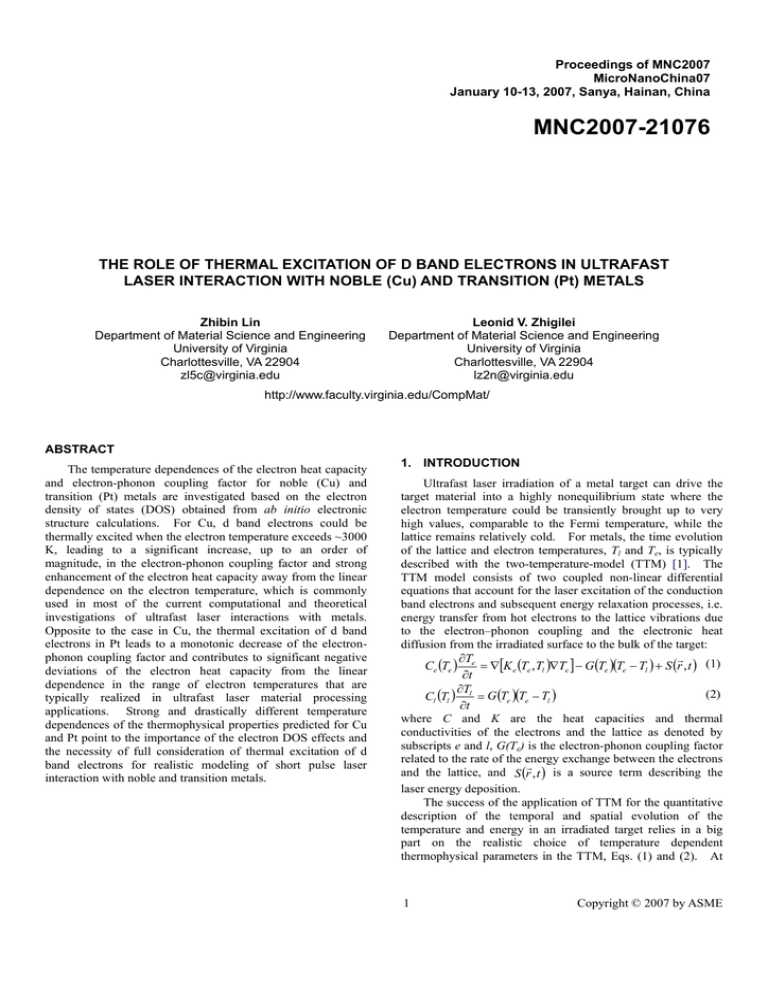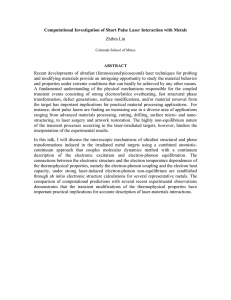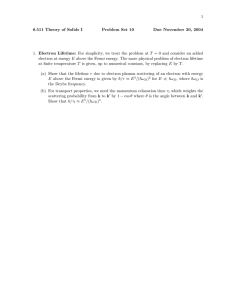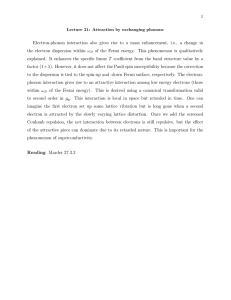Document 13993437
advertisement

Proceedings of MNC2007
MicroNanoChina07
January 10-13, 2007, Sanya, Hainan, China
MNC2007-21076
THE ROLE OF THERMAL EXCITATION OF D BAND ELECTRONS IN ULTRAFAST
LASER INTERACTION WITH NOBLE (Cu) AND TRANSITION (Pt) METALS
Zhibin Lin
Department of Material Science and Engineering
University of Virginia
Charlottesville, VA 22904
zl5c@virginia.edu
Leonid V. Zhigilei
Department of Material Science and Engineering
University of Virginia
Charlottesville, VA 22904
lz2n@virginia.edu
http://www.faculty.virginia.edu/CompMat/
ABSTRACT
The temperature dependences of the electron heat capacity
and electron-phonon coupling factor for noble (Cu) and
transition (Pt) metals are investigated based on the electron
density of states (DOS) obtained from ab initio electronic
structure calculations. For Cu, d band electrons could be
thermally excited when the electron temperature exceeds ~3000
K, leading to a significant increase, up to an order of
magnitude, in the electron-phonon coupling factor and strong
enhancement of the electron heat capacity away from the linear
dependence on the electron temperature, which is commonly
used in most of the current computational and theoretical
investigations of ultrafast laser interactions with metals.
Opposite to the case in Cu, the thermal excitation of d band
electrons in Pt leads to a monotonic decrease of the electronphonon coupling factor and contributes to significant negative
deviations of the electron heat capacity from the linear
dependence in the range of electron temperatures that are
typically realized in ultrafast laser material processing
applications. Strong and drastically different temperature
dependences of the thermophysical properties predicted for Cu
and Pt point to the importance of the electron DOS effects and
the necessity of full consideration of thermal excitation of d
band electrons for realistic modeling of short pulse laser
interaction with noble and transition metals.
1. INTRODUCTION
Ultrafast laser irradiation of a metal target can drive the
target material into a highly nonequilibrium state where the
electron temperature could be transiently brought up to very
high values, comparable to the Fermi temperature, while the
lattice remains relatively cold. For metals, the time evolution
of the lattice and electron temperatures, Tl and Te, is typically
described with the two-temperature-model (TTM) [1]. The
TTM model consists of two coupled non-linear differential
equations that account for the laser excitation of the conduction
band electrons and subsequent energy relaxation processes, i.e.
energy transfer from hot electrons to the lattice vibrations due
to the electron–phonon coupling and the electronic heat
diffusion from the irradiated surface to the bulk of the target:
r
∂T
Ce (Te ) e = ∇[K e (Te , Tl )∇Te ] − G (Te )(Te − Tl ) + S (r , t ) (1)
∂t
∂T
(2)
Cl (Tl ) l = G (Te )(Te − Tl )
∂t
where C and K are the heat capacities and thermal
conductivities of the electrons and the lattice as denoted by
subscripts e and l, G(Te) is the electron-phonon coupling factor
related to the rate of the energy exchange between the electrons
r
and the lattice, and S (r , t ) is a source term describing the
laser energy deposition.
The success of the application of TTM for the quantitative
description of the temporal and spatial evolution of the
temperature and energy in an irradiated target relies in a big
part on the realistic choice of temperature dependent
thermophysical parameters in the TTM, Eqs. (1) and (2). At
1
Copyright © 2007 by ASME
high electron temperatures the thermophysical properties can
be sensitive to the details of the electronic structure of the
target material. It has been shown, in particular, that the
electron heat capacity in Au [2,3] and Pt [4] can be directly
affected by the thermal excitation of d band electrons. A
systematic analysis of the temperature dependence of the
thermophysical properties of Au, reported in Ref. [5], suggests
that at high electron temperatures (>3000 K) the thermal
excitation of d band electrons results in a significant increase of
both the electron-phonon coupling factor and the electron heat
capacity. These changes have strong implications on the
predictions of TTM calculations. Therefore, the approximations
commonly used in most of the current TTM calculations,
namely, a linear temperature dependence of the electron heat
capacity obtained from the Sömmerfeld expansion, which is
valid only at very low electron temperatures [6], and a constant
value for the electron-phonon coupling factor, are inappropriate
for describing the material properties under conditions of
strong ultrafast laser excitation.
In this paper we investigate the effects of thermal
excitation of d band electrons on the temperature dependences
of the electron heat capacity and electron-phonon coupling
factor in Cu and Pt, two metals with very different electronic
structures, typical for noble and transition metals. The
electron DOS obtained from electronic structure calculations
for Cu and Pt are discussed in Section 2. Results from the
analysis of the temperature dependent thermophysical
properties are presented in Section 3 and summarized in
Section 4.
2. ELECTRONIC STRUCTURE CALCULATIONS
In order to investigate the effect of the electron DOS on
the high temperature thermophysical properties of Cu and Pt,
we perform electronic structure calculations based on the
density functional theory using the Vienna Ab-initio Simulation
Package (VASP) [7]. The Projector Augmented Wave (PAW)
potential [8] is used in the calculation, where the exchange
correlation term is treated within the Generalized Gradient
Approximation (GGA). The calculations are done for Cu and
Pt at the equilibrium lattice constants of 3.635 Å and 3.92 Å,
respectively.
The electron DOS for Cu and Pt obtained from VASP at
Te=0 K are shown in Fig. 1. As a member of the noble metal
family, Cu has a filled d band and an electronic structure
similar to Au [5,6]. In the case of Pt, the Fermi level cuts
through the partially filled d band, leading to a very high
density of electron states at the Fermi level, typical for
transition metals. By examining the electron DOS for Cu and
Pt together with the Fermi distribution functions at various
electron temperatures, one can see that for Cu at electron
temperatures less than 0.1 eV (~103 K) only electrons around
the Fermi level are excited, while at Te ~ 1 eV (~104 K) or
higher, the number of excited d band electrons can be
significant and should be taken into account. For Pt, the d
band electrons at energy levels around the Fermi energy can be
easily excited even at low electron temperatures, shifting the
Fermi level to higher energies and altering the thermophysical
properties of the metal in a way different from what would be
expected for the free electron model with a parabolic electron
DOS [6].
3. TEMPERATURE DEPENDENCE
PHYSICAL PROPERTIES
OF
THERMO-
In this section, the electron DOS obtained in Section 2 is
used to investigate the temperature dependences of the electron
heat capacity and electron-phonon coupling in Cu and Pt. The
results are compared with approximations commonly used in
most of the current TTM calculations.
3.1 Electron heat capacity Ce(Te)
In general, the temperature dependence of the electron heat
capacity in metals is described as [6]:
b.
a.
Figure 1. Electron DOS obtained in electronic structure calculations performed with VASP (solid lines) for (a) Cu and (b) Pt. The
Fermi distribution functions are also shown for three different values of the electron temperature. The energy is shown with respect
to the Fermi energy at zero temperature, εF.
2
Copyright © 2007 by ASME
states at energy levels below εF to small density of states above
εF occurs at low electron temperatures, leading to the deviation
of the chemical potential from the Sömmerfeld expansion even
at low electron temperatures.
By incorporating the results for the chemical potential into
Eq. (3), we obtain the electron heat capacity of Cu and Pt as a
function of the electron temperature, Fig. 3. The results are
shown together with the linear approximation C e (Te ) = γTe
obtained from the Sömmerfeld expansion, which is valid only
at low electron temperatures [6].
The difference in the temperature dependence of the
electron heat capacity predicted for Cu and Pt can be
understood from the following analysis. For Cu, below ~3000
K, the region of the electron DOS affected by thermal
excitations ( k BTe ) is similar to the one predicted within the free
Figure 2. Chemical potential for Cu and Pt as a function of the
electron temperature together with the chemical potential
predicted by the free electron model (solid line). Results are
shown with respect to the Fermi level at zero temperature, εF.
∞
∂f (ε , µ , Te )
(3)
g (ε )dε
T
∂
e
−∞
where g(ε) is the electron DOS at the energy level ε,
f (ε , µ , Te ) is the Fermi distribution function, defined
C e (Te ) = ∫ (ε − ε F )
as f (ε , µ , Te ) = {exp[(ε - µ )/k BTe ] + 1}-1 , εF is the Fermi
energy at zero temperature, and µ is the chemical potential at
Te.
The evaluation of the electron heat capacity from Eq. (3)
requires the knowledge of the chemical potential µ as a
function of the electron temperature. The chemical potential
can be found by setting the result of the integration of the
product of DOS and the Fermi distribution function at Te over
all energy levels to be equal to the total number of electrons
[6]. When the electron temperature is much lower than the
Fermi temperature, for the free electron model the chemical
potential can be approximated by the Sömmerfeld expansion
for the electronic free energy:
⎡ π 2 ⎛ k T ⎞2 ⎤
(4)
µ (Te ) = ε F ⎢1 − ⎜⎜ B e ⎟⎟ ⎥
⎢⎣ 12 ⎝ ε F ⎠ ⎥⎦
Fig. 2 shows the chemical potentials for Cu and Pt
calculated at various electron temperatures using DOS from
VASP, together with the chemical potential predicted by the
free electron model, i.e. Eq. (4). For Cu, when Te is below
~3000 K, µ roughly follows the free-electron-like description,
consistent with the good agreement of the shape of the DOS
around the Fermi level with the prediction of the free electron
model, Fig. 1(a). As the electron temperature exceeds ~3000
K, the thermal excitation from the high density of states at the
edge of the d band leads to the increase of the chemical
potential. In the case of Pt, the excitation from high density of
electron model. As a result, the electron heat capacity follows
the linear dependence, with the theoretical value of the
coefficient γ calculated with the number density of s electrons
2
in Cu, ne = 1.0 atom-1, as γ = π 2 ne k B / 2ε F = 71 Jm-3K-1 [6],
being in a good agreement with the experimental value of 98
Jm-3K-2 [9]. At electron temperatures exceeding 3000 K, the
excitation from the large number of d states in Cu results in a
positive deviation of the heat capacity from the linear
temperature dependence. For Pt, the high density of electron
states at the Fermi level ensures that the d electrons can be
easily excited to the s band. The s band has a much smaller
density of states and the shift of the chemical potential to
higher energies, Fig. 2, leads to the negative deviation of the
heat capacity from the linear dependence, Fig. 3(b).
Large deviations of the electron heat capacity from the
linear dependence at high electron temperatures imply that the
use of the linear approximation in TTM calculations can either
significantly overestimate or underestimate the transient values
of the electron temperature during the time of the electronlattice nonequilibrium.
The electron thermal conductivity is related to the electron
heat capacity through the Drude model relationship,
κ (Te , Tl ) = v F2 Ce (Te )τ e (Te , Tl ) / 3 where vF is the Fermi
velocity and τ e (Te , Tl ) is the total electron scattering time with
other electrons and the lattice [2,10]. Therefore, large positive
or negative deviations of the electron heat capacity from the
linear temperature dependence, shown in Fig. 3, would also
affect the electron thermal conductivity, especially at the early
stage of the electron-phonon equilibration, when the electron
temperature is close to its maximum.
3.2 Electron-phonon coupling factor G(Te)
The energy relaxation process between the excited hot
electrons and the lattice in the irradiated target proceeds
through the electron-phonon scattering processes, where the
rate of the energy exchange is characterized by the electronphonon coupling factor [ 11, 12 ]. Despite the fact that a
constant value for the electron-phonon coupling factor is
3
Copyright © 2007 by ASME
a.
b.
Figure 3. Electron heat capacity of (a) Cu and (b) Pt as a function of the electron temperature calculated with DOS obtained from
VASP (solid lines) and using Ce = γTe with (a) γ = 98 Jm-3K-2 and (b) γ = 740 Jm-3K-2 [9] (dashed lines).
a.
b.
Figure 4. Electron-phonon coupling factor of (a) Cu and (b) Pt as a function of the electron temperature calculated with DOS
obtained from VASP. Data presented in this figure is accessible in tabulated form from [15].
commonly used in most of the current computational and
theoretical investigations of ultrafast laser interactions with
metals, growing experimental evidence suggests that the
application of the constant electron-phonon coupling may be
inappropriate for strong laser excitation [2,13,14].
In order to explicitly account for the thermal excitation of
d band electrons in noble and transition metals, we adopt the
expression for the temperature dependent electron-phonon
coupling factor obtained in Ref. [2]:
πhk B λ ω 2
∂f
(5)
G (Te ) =
g 2 (ε )(− )dε
∫
g (ε F )
∂ε
where λ is the electron-phonon coupling constant defined in the
superconductivity theory, <ω2> is the second moment of the
phonon spectrum defined by McMillan [16], and g(εF) is the
electron DOS at the Fermi level εF. At low electron
temperatures, −∂f / ∂ε reduces to a delta function centered at
the Fermi level εF and Eq. (5) recovers the expression for the
electron-phonon coupling constant proposed by Allen in Ref.
11: G0 = πhk B λ ω 2 g (ε F ) . At elevated electron temperatures,
however, −∂f / ∂ε at energy levels away from εF becomes
nonzero and the electron DOS g(ε) at these energy levels needs
to be taken into account in Eq. (5).
For Cu, with the value λ<ω2>=29±4 meV2 measured in
Ref. [17] and DOS shown in Fig. 1(a), we can determine the
room temperature electron-phonon coupling constant from
Allen’s expression, G0 = (5.5±0.7)×1016 Wm-3K-1. The literature
values of G0 for Cu vary between 1 and 20×1016 Wm-3K-1
[18,19,20]. For Pt, due to absence of the experimental data
for λ<ω2>, a value of λ=0.66 [ 21 ] from resistivity
measurements and an approximation of <ω2>=1/2θD2 [22],
where θD=240 K is the Debye temperature for Pt [9], can be
used to estimate the room temperature electron-phonon
4
Copyright © 2007 by ASME
coupling constant for Pt to be G0~2.1×1018 Wm-3K-1. This
value is of the same order of magnitude as the one evaluated
from low temperature reflectivity measurements for Pt,
(1.09±0.5)×1018 Wm-3K-1 [23]. As the verification of the
value of λ<ω2> for Pt is beyond the scope of this paper, and
considering that the experimental value of the electron-phonon
coupling constant in Ref. 23 is measured at relatively low
electron temperatures, from room temperature up to ~465 K,
we set the coupling factor at Te=300 K in Eq. (5) to be equal to
1.09×1018 Wm-3K-1 and obtain λ<ω2> = 142.5 meV2. This
value is then used in Eq. (5) to calculate the temperature
dependence of the electron-phonon coupling factor in a broad
range of electron temperatures as shown in Fig. 4(b).
The electron-phonon coupling factors of Cu and Pt
calculated with Eq. (5) using the electron DOS obtained from
VASP calculations are shown in Fig. 4 [15]. For Cu, the
electron-phonon coupling factor remains close to a constant
value below ~3000 K, similar to Au [5]. However, as the
electron temperature exceeds ~3000 K, the increase of the
coupling factor observed for Cu is significantly steeper as
compared to Au. This observation can be related to the
differences in the electron DOS of the two noble metals, Fig.
1(a) and Fig. 1 of Ref. [5]. The width of d band for Cu, ~3.5
eV, is much smaller than the one for Au, ~6 eV, resulting in a
higher density of states at the high-energy edge of the d band in
Cu as compared to Au. As a result, thermal excitation of d
band electrons in Cu leads to a more significant increase in the
electron-phonon coupling factor. In particular, the electronphonon coupling factor for Cu exceeds the room temperature
value by a factor of 9.5 at Te = 1×104 K, Fig. 4(a), compared to
5.8 for Au at the same electron temperature [5].
In the case of Pt, the strength of the electron-phonon
coupling decreases monotonically as the electron temperature
increases. This could be explained from the perspective of the
role of thermal excitation of d band electrons in noble and
transition metals. For Pt, as the thermal excitation of d band
electron from below the Fermi level to higher energy levels
leads to the increase in the chemical potential, Fig. 2, the
contribution to the electron-phonon coupling from d band
electrons is reduced, whereas for Cu the high value of DOS
from d band ensures the significant contribution from d band
electrons to the coupling, even though the chemical potential
exhibits a temperature dependent behavior similar to Pt when
the electron temperature is higher than ~3000 K. It should be
noted that the trend of the decease in the strength of the
electron-phonon coupling at high electron temperatures for Pt,
Fig. 4(b), is consistent with the experimental value of 2.5×1017
Wm-3K-1, obtained from fitting the results of TTM calculations
to the threshold laser fluences for the onset of surface melting
in Pt films of different thickness [24]. From Fig. 4(b), the
electron-phonon coupling factor for Pt decreases with respect
to its room temperature value by a factor of 2.8 at Te = 0.5×104
K, by a factor of 3.9 at Te = 1×104 K, and by a factor of 5.1 at
Te = 2×104 K.
The large changes in the strength of the electron-phonon
coupling with increasing electron temperature, illustrated in
Fig. 4, suggest that the commonly used assumption of the
temperature-independent electron-phonon coupling can lead to
either significant underestimation or overestimation of the
electron-phonon energy exchange rate following a short pulse
laser irradiation. An adequate description of the temperature
dependence of the electron-phonon coupling factor is important
for a reliable quantitative analysis of practically important
characteristics of the laser-material interaction, such as
threshold fluences for the onset of melting and ablation,
strength of the laser-induced stress wave, and depth of the
melting and/or heat-affected zone.
4. SUMMARY
The temperature dependences of the electron heat capacity
and electron-phonon coupling factor are investigated for a
noble metal Cu and a transition metal Pt based on the electronic
structure calculations performed within the density functional
theory. For Cu, there is no significant thermal excitation of d
band electrons below ~3000 K, and the electron heat capacity
follows a linear dependence on the electron temperature while
the electron-phonon coupling remains constant. As the
electron temperature exceeds ~3000 K, thermal excitation of
electrons from the high-density edge of the d band leads to a
steep and large (up to an order of magnitude) increase of the
electron-phonon coupling factor and a significant positive
deviation of the electron heat capacity from the linear
dependence. For Pt, the shift of the chemical potential away
from the large density of states around the Fermi level results in
a monotonic decrease of the electron-phonon coupling factor
with increasing electron temperature and negative deviations of
the electron heat capacity from the linear dependence. The
contrasting results obtained in this work for Cu and Pt suggest
that the effect of thermal excitation of d band electrons on the
thermophysical properties is sensitive to the structure of the
electron DOS and a detailed analysis of the DOS effects is
required for each target material.
ACKNOWLEDGMENTS
Financial support of this work is provided by the National
Science Foundation through the Thermal Transport and
Thermal Processes Program of the Chemical and Transport
Systems Division (Award No. CTS-0348503).
REFERENCES
[1] S. I. Anisimov, B. L. Kapeliovich, and T. L. Perel'man,
Electron emission from metal surfaces exposed to
ultrashort laser pulses, Sov. Phys. JETP 39, 375 (1974).
[2] X. Y. Wang, D. M. Riffe, Y. S. Lee, and M. C. Downe,
Time-resolved electron-temperature measurement in a
5
Copyright © 2007 by ASME
highly excited gold target using femtosecond thermionic
emission, Phys. Rev. B 50, 8016 (1994).
[3] A. N. Smith and P. M. Norris, Numerical solution for the
diffusion of high intensity, ultrashort laser pulses within
metal films, Proceedings of 11th International Heat
Transfer Conference 5, 241 (1998).
[4] T. Tsuchiya and K. Kawamura, First-principles electronic
thermal pressure of metal Au and Pt, Phys. Rev. B 66,
094115 (2002).
[5] Z. Lin and L. V. Zhigilei, Thermal excitation of d band
electrons in Au: implications for laser-induced phase
transformations, Proc. SPIE 6261, 62610U (2006).
[6] N. W. Ashcroft and N. D. Mermin, Solid State Physics
(Holt, Rinehart and Winston, New York, 1976).
[7] G. Kresse and J. Hafner, Ab initio molecular dynamics for
liquid metals, Phys. Rev. B 47, 558 (1993).
[8] G. Kresse and D. Joubert, From ultrasoft pseudopotentials
to the projector augmented-wave method, Phys. Rev. B 59,
1758 (1999).
[9] American Institute of Physics Handbook, Third edition,
(McGraw-Hill, New York, 1982).
[10] M. Kaveh and N. Wiser, Electron electron-scattering in
conducting materials, Adv. Phys. 33, 257 (1984).
[18] P. B. Corkum, F. Brunel, N. K. Sherman, and T.
Srinivasan-Rao, Thermal response of metals to ultrashortpulse laser excitation, Phys. Rev. Lett. 61, 2886 (1988).
[19] H. E. Elsayed-Ali, T. B. Norris, M. A. Pessot, and G. A.
Mourou, Time-resolved observation of electron-phonon
relaxation in copper, Phys. Rev. Lett. 58, 1212 (1987).
[20] Z. G. Wang, C. Dufour, E. Paumier, and M. Toulemonde,
The Se sensitivity of metals under swift-heavy-ion
irradiation: a transient thermal process, J. Phys.: Condens.
Matter 6, 6733 (1994).
[21] P. B. Allen, Empirical electron-phonon λ values from
resistivity of cubic metallic elements, Phys. Rev. B 36,
2920 (1987).
[22] G. Grimvall, In Selected topics in solid state physics, Vol.
16, edited by E. P. Wohlfahrt (North Holland, Amsterdam
1980).
[23] A. P. Caffrey, P. E. Hopkins, J. M. Klopf, and P. M.
Norris, Thin film non-noble transition metal
thermophysical properties, Microscale Thermophys. Eng.
9, 365 (2005).
[24] J. Hohlfeld, S.-S. Wellershoff, J. Güdde, U. Conrad, V.
Jahnke, and E. Matthias, Electron and lattice dynamics
following optical excitation of metals, Chem. Phys. 251,
237 (2000).
[11] M. I. Kaganov, I. M. Lifshitz, and L. V. Tanatarov,
Relaxation between electrons and crystalline lattices, Sov.
Phys. JETP 4, 173 (1957).
[12] P. B. Allen, Theory of thermal relaxation of electrons in
metals, Phys. Rev. Lett. 59, 1460 (1987).
[13] J. P. Girardeau-Montaut and C. Girardeau-Montaut,
Theory of ultrashort nonlinear multiphoton photoelectric
emission from metals, Phys. Rev. B 51, 13560 (1995).
[14] J. K. Chen and J. E. Beraun, Modeling of ultrashort laser
ablation of gold films in vacuum, J. Opt. A: Pure Appl.
Opt. 5, 168 (2003).
[15] Electron temperature dependences of thermophysical
properties of Cu and Pt and several other metals are
accessible
in
tabulated
form
from
http://www.faculty.virginia.edu/CompMat/electronphonon -coupling/
[16] W. L. McMillan, Transition temperature of strong-coupled
superconductors, Phys.Rev. 167, 331 (1968).
[17] S. D. Brorson, A. Kaeroonian, J. S. Moodera, D. W. Face,
T. K. Cheng, E. P. Ippen, M. S. Dresselhaus and G.
Dresselhaus, Femtosecond room-temperature measurement
of the electron-phonon coupling constant λ in metallic
superconductors, Phys. Rev. Lett. 64, 2172 (1990).
6
Copyright © 2007 by ASME





